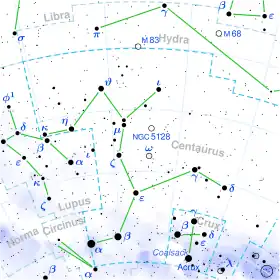Lambda Centauri
Lambda Centauri, Latinized from λ Centauri, is a star in the southern circumpolar constellation of Centaurus. It has an apparent visual magnitude of +3.13,[2] which is bright enough to be seen with the naked eye from the Southern Hemisphere and places it among the brighter members of this constellation. The star is close enough that its distance can be determined directly using the parallax technique, which gives a value of approximately 470 light-years (140 parsecs) from the Sun. Although a putative solitary star, it has a candidate proper motion companion at an angular separation of 0.73 arcseconds along a position angle of 135°.[14] The nebula IC 2944 lies nearby.[15]
 | |
| Observation data Epoch J2000.0 Equinox J2000.0 | |
|---|---|
| Constellation | Centaurus |
| Right ascension | 11h 35m 46.87908s[1] |
| Declination | −63° 01′ 11.3965″[1] |
| Apparent magnitude (V) | +3.13[2] |
| Characteristics | |
| Spectral type | B9 III[3][4] |
| U−B color index | −0.19[2] |
| B−V color index | −0.04[2] |
| Astrometry | |
| Radial velocity (Rv) | −1.4[5] km/s |
| Proper motion (μ) | RA: −34.270[1] mas/yr Dec.: −7.912[1] mas/yr |
| Parallax (π) | 6.9253 ± 0.3316 mas[1] |
| Distance | 470 ± 20 ly (144 ± 7 pc) |
| Absolute magnitude (MV) | −2.35[6] |
| Details | |
| Mass | 4.5[7] M☉ |
| Radius | 5.5[8] R☉ |
| Luminosity | 739[9] L☉ |
| Surface gravity (log g) | 3.04[10] cgs |
| Temperature | 9,880[11] K |
| Metallicity [Fe/H] | +0.41[10] dex |
| Rotational velocity (v sin i) | 183[12] km/s |
| Other designations | |
| Database references | |
| SIMBAD | data |

Lambda Centauri is a B-type giant star[16] with a stellar classification of B9 III[3] (although it has also been classified as A1 III).[11] It has about 5.5[8] times the radius of the Sun and is rotating rapidly with a projected rotational velocity of 183 km/s.[12] The latter is giving the star an oblate shape with an equatorial bulge that is 17% larger than the polar radius.[17] The star's outer atmosphere has an effective temperature of 9,880 K,[11] giving it a blue-white hue.
Based upon the position and movement of this star through space, it is a likely member of the Gould Belt. In particular, it belongs to the Lower Centaurus–Crux (LCC) group of the Scorpius–Centaurus association, which is the nearest OB association to the Sun. This is a loose grouping of stars that share a common motion through space and therefore formed in the same molecular cloud. The LCC group has an estimated age of 16–20 million years and is centered on a mean distance of 380 light-years (120 parsecs) from Earth.[18]
Gallery
References
- Brown, A. G. A.; et al. (Gaia collaboration) (August 2018). "Gaia Data Release 2: Summary of the contents and survey properties". Astronomy & Astrophysics. 616. A1. arXiv:1804.09365. Bibcode:2018A&A...616A...1G. doi:10.1051/0004-6361/201833051. Gaia DR2 record for this source at VizieR.
- Johnson, H. L.; et al. (1966), "UBVRIJKL photometry of the bright stars", Communications of the Lunar and Planetary Laboratory, 4 (99): 99, Bibcode:1966CoLPL...4...99J
- Houk, Nancy (1979), "Michigan catalogue of two-dimensional spectral types for the HD stars", Ann Arbor: Dept. Of Astronomy, Ann Arbor, Michigan: Dept. of Astronomy, University of Michigan, 1, Bibcode:1978mcts.book.....H
- Eggleton, P. P.; Tokovinin, A. A. (September 2008). "A catalogue of multiplicity among bright stellar systems". Monthly Notices of the Royal Astronomical Society. 389 (2): 869–879. arXiv:0806.2878. Bibcode:2008MNRAS.389..869E. doi:10.1111/j.1365-2966.2008.13596.x. S2CID 14878976.
- Evans, D. S. (June 20–24, 1966), Batten, Alan Henry; Heard, John Frederick (eds.), "The Revision of the General Catalogue of Radial Velocities", Determination of Radial Velocities and their Applications, Proceedings from IAU Symposium no. 30, University of Toronto: International Astronomical Union, vol. 30, p. 57, Bibcode:1967IAUS...30...57E
- Eggen, O. J. (1984). "The A0 stars". Astrophysical Journal Supplement Series. 55: 597. Bibcode:1984ApJS...55..597E. doi:10.1086/190971.
- Kaler, James B. (May 25, 2012), "Lambda Centauri", STARS, retrieved 2021-06-29.
- Underhill, A. B.; et al. (November 1979), "Effective temperatures, angular diameters, distances and linear radii for 160 O and B stars", Monthly Notices of the Royal Astronomical Society, 189 (3): 601–605, Bibcode:1979MNRAS.189..601U, doi:10.1093/mnras/189.3.601
- McDonald, I.; Zijlstra, A. A.; Boyer, M. L. (2012). "Fundamental parameters and infrared excesses of Hipparcos stars". Monthly Notices of the Royal Astronomical Society. 427 (1): 343–357. arXiv:1208.2037. Bibcode:2012MNRAS.427..343M. doi:10.1111/j.1365-2966.2012.21873.x. S2CID 118665352.
- Erspamer, D.; North, P. (2003). "Automated spectroscopic abundances of a and F-type stars using echelle spectrographs. II. Abundances of 140 A-F stars from ELODIE". Astronomy and Astrophysics. 398 (3): 1121–1136. arXiv:astro-ph/0210065. Bibcode:2003A&A...398.1121E. doi:10.1051/0004-6361:20021711. S2CID 1109164.
- Zorec, J.; et al. (July 2009), "Fundamental parameters of B supergiants from the BCD system. I. Calibration of the (λ_1, D) parameters into Teff", Astronomy and Astrophysics, 501 (1): 297–320, arXiv:0903.5134, Bibcode:2009A&A...501..297Z, doi:10.1051/0004-6361/200811147, S2CID 14969137
- Royer, F.; et al. (October 2002), "Rotational velocities of A-type stars in the northern hemisphere. II. Measurement of v sin i", Astronomy and Astrophysics, 393 (3): 897–911, arXiv:astro-ph/0205255, Bibcode:2002A&A...393..897R, doi:10.1051/0004-6361:20020943, S2CID 14070763
- "lam Cen". SIMBAD. Centre de données astronomiques de Strasbourg. Retrieved 2021-06-27.
{{cite web}}: CS1 maint: postscript (link) - Shatsky, N.; Tokovinin, A. (January 2002), "The mass ratio distribution of B-type visual binaries in the Sco OB2 association", Astronomy and Astrophysics, 382: 92–103, arXiv:astro-ph/0109456, Bibcode:2002A&A...382...92S, doi:10.1051/0004-6361:20011542, S2CID 16697655
- Baume, G.; et al. (September 2014), "A deep and wide-field view at the IC 2944/2948 complex in Centaurus*", Monthly Notices of the Royal Astronomical Society, 443 (1): 411–422, arXiv:1406.0708, Bibcode:2014MNRAS.443..411B, doi:10.1093/mnras/stu1108.
- O'Meara, Stephen James (2002), The Caldwell Objects, Cambridge University Press, pp. 399–400, ISBN 0-521-82796-5
- Belle, G. T. (2012), "Interferometric observations of rapidly rotating stars", The Astronomy and Astrophysics Review, 20 (1): 51, arXiv:1204.2572, Bibcode:2012A&ARv..20...51V, doi:10.1007/s00159-012-0051-2, S2CID 119273474.
- Bobylev, V. V.; Bajkova, A. T. (September 2007), "Kinematics of the Scorpius–Centaurus OB association", Astronomy Letters, 33 (9): 571–583, arXiv:0708.0943, Bibcode:2007AstL...33..571B, doi:10.1134/S1063773707090010, S2CID 15785349

